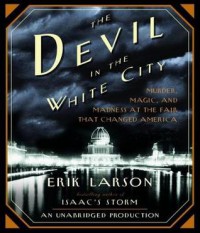The Devil in the White City Murder, Magic and Madness at the Fair That Changed America
 So, there’s this scene in David Fincher's Zodiac in which Jake Gyllenhaal's character, Robert Graysmith, visits the home of someone he believes to be the famed Zodiac killer. As Graysmith ventures down in the suspect’s basement, there’s this sense of dread that’s instilled in the viewer as they wonder if Graysmith will make it out alive. As Fincher lets the tensions escalate and the claustrophobia rise, Graysmith grows frantic and escapes the first chance he gets. There have been movies in the past and while I’m sure there will be movies yet to be made that will implore this same strategy in an effort to frighten it’s audience but until now, I haven’t read a book that gave me that same feeling. Until now.
So, there’s this scene in David Fincher's Zodiac in which Jake Gyllenhaal's character, Robert Graysmith, visits the home of someone he believes to be the famed Zodiac killer. As Graysmith ventures down in the suspect’s basement, there’s this sense of dread that’s instilled in the viewer as they wonder if Graysmith will make it out alive. As Fincher lets the tensions escalate and the claustrophobia rise, Graysmith grows frantic and escapes the first chance he gets. There have been movies in the past and while I’m sure there will be movies yet to be made that will implore this same strategy in an effort to frighten it’s audience but until now, I haven’t read a book that gave me that same feeling. Until now.H.H. Holmes in an evil man. The con-man who terrorized wayward women in the city of Chicago during the turn of the 20th century is one of history’s greatest villains. Notorious for being America’s first serial killer, Holmes brutally murdered his way through the windy city during its rise to prominence. However, due to the unfortunate timing of his killing spree, Holmes will be forever linked to what was to be considered Chicago’s finest moment, the 1893 World’s Colombian Exposition.
Fortunately for Holmes, Chicago was a hole. The city was known for its numerous missing persons, it's polluted river and overpopulation - something that attracted a man like Holmes and his insatiable appetite for murder. The perception of Chicago needed to change. So, in an effort to add some prestige, W.H. Burnham and his pals lobbied hard to host a world’s fair. They desperately wanted something to compete with Europe, most notably Paris, and the recently constructed Eiffel Tower. They felt a grand display of cultures from all over the globe would win the hearts of the masses.
The construction of the fair was difficult to say the least. The fair was coming at a time when the country was financially unstable. Several banks foreclosed, their respective executives were committing suicide and those that provided the funds to Burnham and his group felt consistent doubt and worry over the fair’s progress. The location was less than perfect and Burnham's associates and employees seemed to court sickness and death on a regular basis.
While the two events, Holmes killing spree and the fair are forever intertwined with one another, I felt the consistent switching back and forth between the two tales hindered each story line rather than enhancing the book as a whole. Larson’s writing of Burnham's failures and struggles were riveting at times but his heavy handed description of the types of plants and shrubs that made up the fairgrounds caused me at times to just zone out.
The same cannot be said about Holmes. The way that man's mind worked was extraordinary. He was leaps and bounds ahead of what can only be described as a hopelessly inept police force. Because of the sordid state of the city, Holmes literally got away with murder on a regular basis. People often vanished and with Holmes' standing in the community, his question of guilt was often overlooked. He was a cunning son of a bitch to say the least. He always had an excuse, alibi or a reasonable explanation to cover his tracks. Even when he was finally apprehended, he stumped the detectives continuously. It seemed as if you could not convince even Holmes himself that he was guilty.
Overall, this book is one hell of an achievement. Larson is an extraordinary talent; taking a genre like historical non-fiction and writing it similarly to an engaging novel. I can’t recommend this enough. While I had some trouble making it through a lot of the heavier architecture-influenced chapters, Larson always made sure to remind you just how seemingly impossible this whole affair was.




